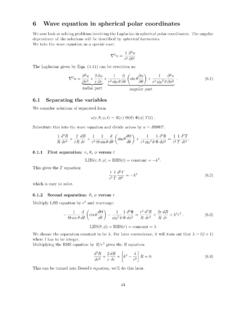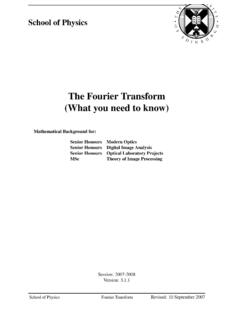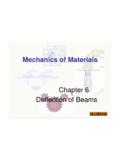Transcription of Lecture 15: Vector Operator Identities (RHB 8.8 all
1 Lecture 15: Vector Operator Identities (RHB )There are a large number of Identities for div, grad, and curl. It s not necessary to knowallof these, but you are advised to be able to produce from memory expressions for r, r, r, (r), (a r), (a r), (fg), and 1 2 3 4 below. You should befamiliarwiththe rest and to be able toderiveandusethem when necessary!Most importantly you should be at ease with div, grad and curl. This only comes throughpractice and deriving the various Identities gives you just that. In these derivations theadvantages of suffix notation, the summation convention and ijkwill become what follows, (r) is a scalar field;A(r) andB(r) are Vector 1. Distributive Laws1. (A+B) = A+ B2. (A+B) = A+ BThe proofs of these are straightforward using suffix or x y z notation and follow from thefact that div and curl are linear 2.
2 Product LawsThe results of taking the div or curl ofproductsof Vector and scalar fields are predictablebut need a little care:-3. ( A) = A+A 4. ( A) = ( A) + ( ) A= ( A) A Proof of (4):first using ijk ( A) =ei ijk xj( Ak)=ei ijk( ( xjAk)+Ak( xj ))= ( A) + ( ) Aor avoiding ijkand using x y z notation: ( A) = exeyez x y z Ax Ay Az .Thexcomponent is given by ( Az) y ( Ay) z= ( Az y Ay z) +( y)Az ( z)Ay= ( A)x+[( ) A]x57A similar proof holds for we have used Cartesian coordinates in our proofs, the Identities hold in all coor-dinate 3. Products of Two Vector FieldsThings start getting complicated!5. (A B) = (A )B+ (B )A+A ( B) +B ( A)6. (A B) =B ( A) A ( B)7. (A B) =A( B) B( A) + (B )A (A )BProof of (6): (A B) = xi ijkAjBk= ijk( Aj xi)Bk+ ijkAj( Bk xi)=Bk kij Aj xi Aj jik Bk xiThe proofs of (5) and (7) involve the product of two epsilon ijks.
3 For example, this is whythere are four terms on the rhs of (7).All other results involving one can be derived from the above :Ifais aconstantvector, andris the position Vector , show that (a r) = (a )r=aIn Lecture 13 we showed that (a r) =afor constanta. Hence, we need only evaluate(a )r=ai xiejxj=aiej ij=aiei=a(1)and the identity :Show that ( r) = 0 where is 6. ( r) = ( r) r ( ) = 0 0 Example:Show that (r 3r) = 0, (wherer=|r|as usual).Using identity (3), we have (r 3r) =r 3( r) +r (r 3)58We have previously shown that r= 3 and that (rn) =nrn 2r. Hence (r 3r) =r 3( r) +r (r 3)=3r3+r ( 3r5r)=3r3+ 3r5r2= 0(except atr= 0)15. 4. Identities involving 2 s8. ( ) = 0curl grad is always ( A) = 0div curlAis always ( A) = ( A) 2 AProofs are easily obtained in Cartesian coordinates using suffix notation:-Proof of (8) ( ) =ei ijk xj( )k=ei ijk xj xk =ei ijk xk xj (since 2 x y= 2 y xetc)=ei ikj xj xk (interchanging labelsjandk)= ei ijk xj xk (ikj ijkgives minus sign)= ( ) = 0since any Vector equal to minus itself is must be zero.
4 Proof of (9) is similar. It is importantto understand how these two Identities stem from the anti-symmetry of ijkhence the anti-symmetry of the curl curl operation.(10) can be proven using the identity for the product of two ijk. Although the proof istedious it is far simpler than trying to use xyz (try both and see!)(10) is an important result and is used frequently in electromagnetism, fluid mechanics, andother field theories .Finally, when a scalar field depends only on the magnitude of the position vectorr=|r|,we have 2 (r) = (r) +2 (r)rwhere the prime denotes differentiation with respect tor. Proof of this relation is left to commencing with integral Vector calculus we review here polar co-ordinate Co-ordinate SystemsHeredVindicates a volume element anddAan areaelement.
5 Note that different conventions, the angles and , are sometimes used,in particular in the Mathematics Several Variable Calculus polar co-ordinatesCylindrical polar co-ordinatesSpherical polar co-ordinates60











